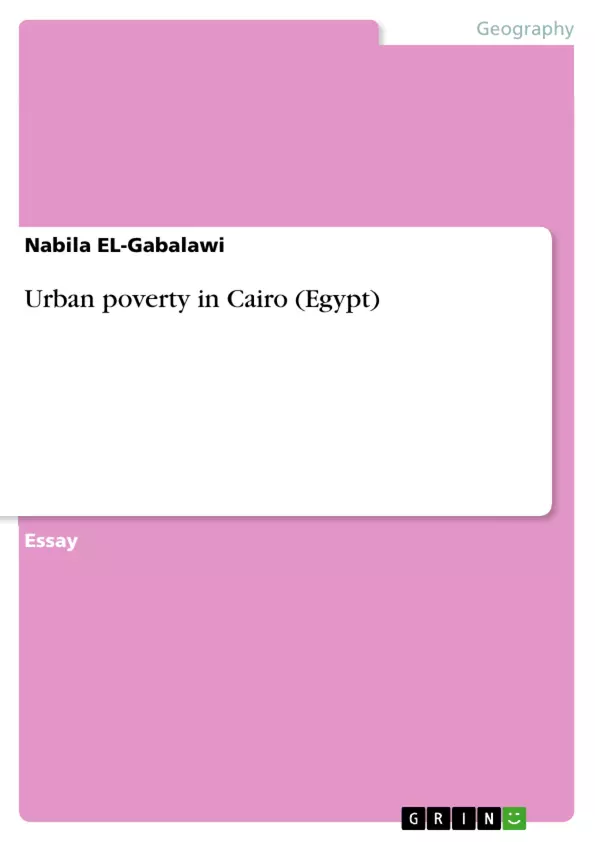This paper summarises the characteristics of urban poverty in Greater Cairo (GC) region as one of the most important regions not only in Egypt but also in MENA region. The targeted region is administratively extended across three governorates which are Cairo, Giza, and Qaliobeia. It includes the urban areas of the three governorates with exception to only some scattered areas that constitutes an area of about 2900 km2. Discussed within are the factors that contributed to urban poverty within GC and its associated problems. The paper also discusses the experienced difficulties by the Egyptian Government while alleviating the urban poverty prevalence, which resulted from the complex nature of poverty in urban areas of GC region.
In order to understand the nature of urban poverty in GC it is important to recognise the definition of Urban Poverty which refers to poverty in urban areas. However, poverty has lots of definitions according to the approach that used for defining it; whether it is a monetary approach based on incomes and consumptions, or based on the capabilities of people or their social situation if they are included or excluded or based on a participatory approach that considers how poor people defined themselves as poor (Laderchi, Saith and Stewart, 2003).
The World Bank refers to the Urban Poor as those who are deprived from access to employment opportunities and income, adequate and secure housing and services, living in peaceful and healthy environments with social protection mechanisms, and access to adequate health and education opportunities (World Bank, 2008)
Urban Poverty has a different nature from a place to another as each region has its unique national, demographic, economic and governance contexts. Furthermore, the factors that formulated its nature in every country are different (Sims, 2003).
Inhaltsverzeichnis (Table of Contents)
- Introduction
- The nature of Urban Poverty in Greater Cairo
- The factors of Urban Growth in GC and its contribution to Urban Poverty
- The link between Urban Poverty and the informal settlements
Zielsetzung und Themenschwerpunkte (Objectives and Key Themes)
This paper examines the characteristics of urban poverty in Greater Cairo (GC), a region of significant importance in both Egypt and the MENA region. The paper explores the factors that contribute to urban poverty in GC, including rapid urbanization, internal migration, and the formation of informal settlements. Additionally, it highlights the challenges faced by the Egyptian government in addressing urban poverty in GC, particularly due to the complex nature of poverty in the region's urban areas.
- The nature of urban poverty in Greater Cairo
- Factors contributing to urban poverty in GC
- The impact of urbanization on poverty
- The role of informal settlements in urban poverty
- Challenges faced by the Egyptian government in alleviating urban poverty
Zusammenfassung der Kapitel (Chapter Summaries)
The introduction establishes the context for the paper, highlighting the importance of understanding urban poverty in Greater Cairo. It defines urban poverty and discusses its multifaceted nature, considering various approaches to its definition.
The second section delves into the characteristics of urban poverty in Greater Cairo, outlining the factors that contribute to its prevalence. It explores the rapid urban growth in the region, driven by historical, economic, and political factors. The section also examines the environmental and demographic challenges associated with rapid urbanization, such as pollution, overcrowding, and unemployment.
The third section focuses on the link between urban poverty and the formation of informal settlements. It explains how the growth of informal settlements in Greater Cairo is driven by various factors, including natural population growth, housing policies, urban management, and governance. The section highlights the prevalence of slums in the region and their role in shaping the landscape of urban poverty.
Schlüsselwörter (Keywords)
Urban Poverty, Greater Cairo, Informal Settlements, Urbanization, Environmental Problems, Internal Migration, Egyptian Government, Housing Policies, Slums.
- Arbeit zitieren
- Nabila EL-Gabalawi (Autor:in), 2008, Urban poverty in Cairo (Egypt), München, GRIN Verlag, https://www.grin.com/document/156541



